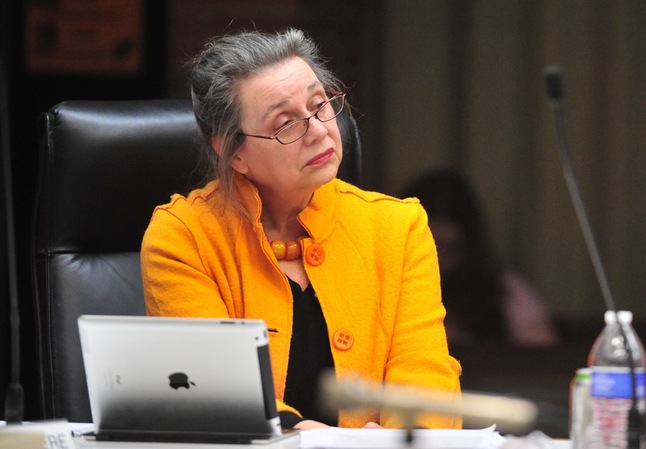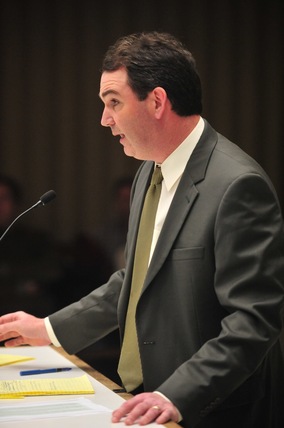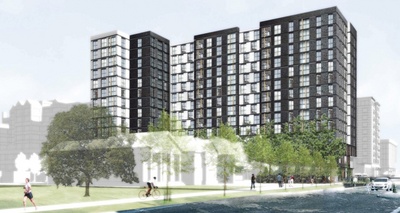
City Council Member Sabra Briere, D-1st Ward, believes it's time to evaluate the impact of D1 zoning on adjacent neighborhoods.
Ryan J. Stanton | AnnArbor.com
The only reason given for the postponement was that Council Member Marcia Higgins, D-4th Ward, was absent from the meeting. Christopher Taylor, D-3rd Ward, was absent, too.
Council Member Sabra Briere, D-1st Ward and the primary sponsor of the resolution, said Higgins wanted to be part of the deliberations.
Aside from that brief statement, council members didn't publicly discuss the proposed six-month moratorium, which was the subject of legal threats Tuesday night.

Pat Lennon, a Kalamazoo-based attorney representing the developer of a proposed 14-story high-rise at 413 E. Huron St., appears before the Ann Arbor City Council Tuesday night in opposition to a moratorium on downtown developments.
Ryan J. Stanton | AnnArbor.com
"Our client was stunned to learn about this proposed moratorium virtually on the eve of their opportunity to be considered by City Council," said Pat Lennon, an attorney representing the developer, Georgia-based Carter.
"I'm here tonight because we think this is a pretty extreme situation," he said.
Lennon said if the moratorium gets approved, his client will be reviewing its legal rights. He said the moratorium raises a number of legal questions.
"First, based on all the circumstances in this case, it appears to be directed at one applicant and one project. That's our client," he said.
"We heard no mention of a moratorium prior to our client's progress through the application process," he added. "This has been going on for months. We heard no mention of a review of the D1 (core downtown zoning district) or any other issue for that matter, so we are understandably frustrated by this turn of events."
The council will take up the issue of the moratorium, which Briere proposed to give the city's Planning Commission time to re-evaluate the city's downtown zoning, at its March 4 meeting.
Also postponed Tuesday night was a resolution sponsored by Briere and Higgins to reconvene the city's Design Guidelines Task Force to review and make recommendations to the City Council regarding improvements to the city's design guidelines and design review process.
A revised version of Briere's moratorium resolution was circulated on Tuesday with Council Member Stephen Kunselman, D-3rd Ward, joining as a co-sponsor. It would give the Planning Commission until June 4 to evaluate the impact of D1 zoning on adjacent neighborhoods.
All petitions for site plan approval in the D1 core downtown zoning district would be deferred for up to six months with only a few exceptions. One exception would be petitions recommended for approval by the Planning Commission but not considered by the City Council prior to Feb. 19.
Because the 413 E. Huron project wasn't recommended for approval by the Planning Commission, it would be put on hold under the moratorium.
Susan Friedlaender, an attorney representing the property owner, Connecticut-based Greenfield Partners, called the moratorium ill-advised. She suggested the council might be reacting to the concerns of a "vocal minority" that has spoken out against the 413 E. Huron project.
Friedlaender said when the city adopted the new A2D2 zoning for downtown in 2009 it gave others the reasonable expectation the new zoning laws would have some measure of stability.

A north perspective for the 14-story high-rise proposed at 413 E. Huron St. in downtown Ann Arbor
Humphreys & Partners Architects
After acquiring the properties along Huron Street near Division, the development team submitted preliminary design plans to the city in late September.
The plans call for 216 apartment units with 533 bedrooms, 132 underground parking spaces for automobiles and 144 parking spaces for bicycles. The new high-rise would replace a vacant 10,300-square-foot building, a former Papa John's pizza store and a house.
The project has been hugely controversial and is being opposed by the city's Historic District Commission and many residents who live in the adjacent historic neighborhoods. They packed the council chambers Tuesday night to watch the council's deliberations.
Attorney Susan Morrison is representing Ilene and Norman Tyler, who are residents in the Division Street Historic District. Their house sits in the would-be shadow of the proposed high-rise.
Morrison sent a two-page letter to Mayor John Hieftje and council members on Tuesday urging adoption of the moratorium resolution.
"As noted in the resolution's preamble, the city has compelling reasons to adopt this moratorium resolution," it reads. "Among other valid reasons, it should be noted that conforming the zoning ordinance to the adopted master plan is indisputably a valid basis for a temporary moratorium."
Morrison noted the council's revised resolution gives any aggrieved petitioner the right to a hearing in front of the City Council for potential relief from the moratorium.
Lennon maintains the timing is dubious.
"At the end of the day, it appears to us that the proposed moratorium and potential changes to the ordinance can be seen as a last effort to avoid making a final decision on our client's by-right project," he said. "In our view, any such use of the moratorium process would be improper."
A memo accompanying the moratorium resolution notes the city's May 2009 Downtown Plan has stated goals to "protect the livability of residentially zoned neighborhoods adjacent to downtown" and to "encourage design approaches which minimize the extent to which high-rise buildings create negative impacts in terms of scale, shading and blocking views."
The city's November 2009 Master Plan also talks about instances in which houses are overshadowed by larger commercial, residential or institutional buildings that are out of scale.
"New downtown development will be encouraged," it states, "But at the same time, existing assets and valued downtown characteristics will be conserved and strengthened. This balance between conservation and change will be fostered by emphasizing the use of incentives and guidelines."
University of Michigan professor Doug Kelbaugh, former dean of architecture and urban planning, told council members a review of the downtown zoning makes sense.
"Ann Arbor has the opportunity to have a well-defined downtown core with crisp edges, rather than the usual loose checkerboard of most American downtowns," he said. "If we limited the D1 zone to the true inner core, it would lend a distinctive character to our city's center."
Kelbaugh added, "Right now with the existing code, you could build 180-foot buildings right across the street from Hill Auditorium, right across the street from the Hands On Museum, right next to Nickels Arcade, right next to some historic houses. It's a pretty abrupt transition."
Ryan J. Stanton covers government and politics for AnnArbor.com. Reach him at ryanstanton@annarbor.com or 734-623-2529. You also can follow him on Twitter or subscribe to AnnArbor.com's email newsletters.